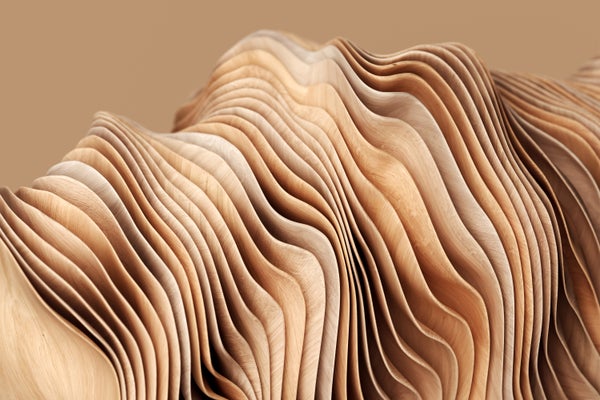Wood is one of humanity’s oldest and most versatile building materials—but turning tree trunks into today’s plywood and two-by-fours generates huge amounts of waste. Each year the U.S. alone produces about 18 million tons of scrap wood, and more than 12 million tons of it ends up in landfills. But researchers have now found a way to turn some of this waste into a wood “ink” that could eventually be used to 3D-print items such as furniture or architectural elements. The resulting material, described in a study published March 15 in Science Advances, looks, feels and smells like natural wood and is physically similar to work with.
Wood-based 3D-printing itself isn’t new. Existing inks, though, are typically made by mixing sawdust with a binder. This produces a wood-like composite that lacks many of the physical and aesthetic properties that give wood its appeal. In the new process, “we tried to mimic natural wood,” says Rice University materials science researcher Muhammad Rahman, one of the authors of the study.
Natural wood is made up mostly of organic polymers called cellulose and lignin, along with smaller amounts of pectin, wax and other compounds. To convert wood scraps into ink for 3D printing, the researchers started by combining just lignin and cellulose, keeping the ratio of these materials the same as that found in natural wood. For this part of the process, Rahman says, any kind of wood or wood waste can be used. In fact, “it does not even need to be wood,” he adds. “You can [use] any plant that has lignin and cellulose [and] deconstruct it and then mix it.”
On supporting science journalism
If you're enjoying this article, consider supporting our award-winning journalism by subscribing. By purchasing a subscription you are helping to ensure the future of impactful stories about the discoveries and ideas shaping our world today.
The main challenge was creating an ink with exactly the right “flow,” a property that scientists call rheology. The 3D-printing method they used, called direct ink writing (DIW), involves squeezing liquid inks through a microscale nozzle to “draw” the desired structure a little bit at a time. DIW printers, which are common in laboratories and are used in low-volume manufacturing, can print 3D structures from almost any material—including polymers, ceramics, glass, cement or metals—provided the ink is manufactured correctly. “You need a perfect rheology,” Rahman says.
To get that perfect mix, the researchers experimented with two different forms of cellulose: long strands of molecules called nanofibers and crystallized structures called nanocrystals in a water-based solution. “If you use more nanofiber than nanocrystal, you get chunky globules that you cannot print, or you need very high pressures to print that,” Rahman explains. Conversely, too much nanocrystal makes the ink watery, and the resulting printed structures don’t hold their shape.
The researchers found the right combination of cellulose molecules and used lignin to bind them together. Because they didn’t include any of the synthetic additives used in existing types of wood printing, both the ink and resulting printed structures can be recycled back to their constituent parts.
As a proof of concept, the researchers printed miniature furniture, letters of the alphabet and a honeycomb lattice. These structures did need some additional processing to fully maintain their shape: Air-drying deformed them, so the research team freeze-dried them at −80 degrees Celsius (-112 degrees Fahrenheit) in a vacuum. Next, they were subjected to heat treatment at 180 degrees C (356 degrees F), which caused the lignin to soften and bind better.
Structures printed this way had mechanical and thermal properties that resembled ones made from a natural hardwood: they bent and compressed in a similar way and had comparable fire resistance, Rahman explains. “Our next goal is to increase the mechanical properties further so that it can surpass the properties of hardwood,” he says. For example, certain additives could potentially make the wood more fire-resistant.
Kevin Estelle, who researches micro-DIW processes at Washington State University, says the new study offers a thorough assessment of ways to tweak wood ink’s efficacy. DIW “is best used to create highly complex and customized parts with a broad range of materials,” he says. But he notes that this type of 3D printing is relatively slow and questions whether a process such as this could replace traditional ways of producing wood parts for furniture or building on a larger scale.
Rahman thinks further adjustments to the new wood ink’s rheology could allow for quicker printing times. He and his team are also trying to cut down on the energy-intensive postprocessing that their printed products currently need to keep their shape. Future studies could compare how the energy and costs of their recycling method stack up against those of traditional wood processing.
